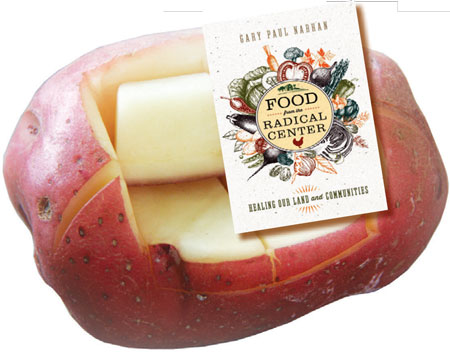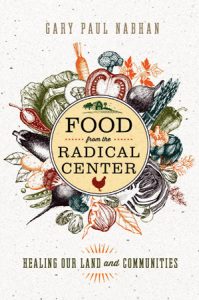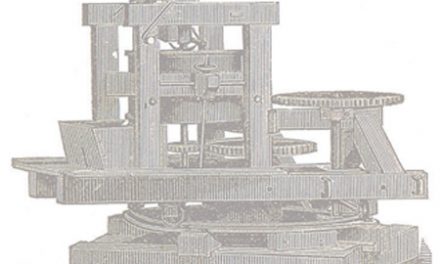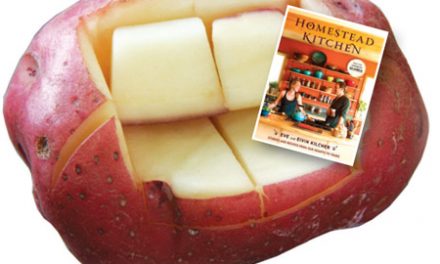 Reviewed by John Forti.
Reviewed by John Forti.
Food from the Radical Center:
Healing Our Land and Communities
A review of Gary Nabhan’s new book from Island Press.
Gary Nabhan has been writing about food for more than 20 years, and is recognized by many as a founder of the local food movement. His new book brings to life stories that demonstrate food’s ability to unite people from rural enclaves and big cities, red states and blue states, poverty and great wealth, religious and science-based communities, and even those across our own kitchen tables; stories which range from grassroots efforts to prevent soil erosion to the recovery of bison on tribal and private ranches.
In Food from the Radical Center Nabhan questions whether our country can heal from recent traumas caused by our vast political divides. In order to do so, people will “… need ways to come together, listen and engage with those who we presume to be our adversaries, opponents, or devil’s advocates.” Even a Washington miracle couldn’t spackle over our deep divisions.

“When we are sowing seeds, planting trees, building check dams or serving food to the poor, our humanity and kinship with the other-than-human-world speaks louder than our ideologies.” Nabhan calls this “conservation you can taste” and suggests that when we can see, smell, touch, and taste a landscape, it becomes something we value and want to steward.
Living in an age where news stories only seem to pit opposing viewpoints against each other, the center can seem nebulous if nonexistent. Nabhan asserts that, with the patience of a gardener, we can restore conversation, community, and the trust that helps us come together and collaborate to restore riches such as enduring seeds, rare breeds, “the forgotten fruits, the elusive fish, the still-surviving game, the dutiful pollinators, the hidden microbes and worms working in our most fertile soils, and the clean waters hidden in springs and aquafers beneath our feet.” Around shared experiences from our common landscape, a delicious revolution grows.
Nabhan notes that divergent viewpoints are often what make collaborations successful, offering many examples of community-based projects that have succeeded after top-down approaches failed. Diverse groups of stakeholders have come together to restore threatened species, for example, or to revive a rare heirloom squash or forage huckleberries in a once-threatened habitat. The fruits of cooperation are sweet, and the work of restoring and preserving is something to be savored.
Communities with histories of racial and class conflict have successfully cultivated heritage foods that bring diverse people together around a common table for healing and celebration, while also preserving vital genetic biodiversity in our landscapes. Nabhan explores reintroduced crops and ancient grains that have helped to heal cultural divides and breathe new life into place-based cuisines. Throughout the book, Nabhan explores how partnerships among cultural groups, heirloom historians, museum preservationists, scientists, restaurateurs, bakers, brewers, and millers are helping to rebuild farms, agricultural markets, and a network of regional food webs that demonstrate the strength of collaboration from across the aisle, and prove the axiom that many hands make light work.

Gary Paul Nabhan Publisher: Island Press
Nabhan says that eco-culinary engagement and meaningful conversations around the restoration of shared resources mean that the diversity of foods on American tables is now greater than at any time in the last century. He points to an increase in the distribution of heirloom plants and to the number of cultivated plant varieties in the U.S., which has more than doubled during the last 30 years, growing from 9,720 in the mid-1980s to 21,640 in the mid-2010s.
He also recognizes there are skeptics who adamantly maintain that the radical center is just a euphemism for sitting on the fence or trying to please everyone and satisfy no one. To this he posits a question posed by one of his Quaker friends: “How can they hope to engage others in the restoration of biodiversity if they are reluctant to let the awesome complexity of human diversity into the decision-making room?”
As the local food movement grows, so too does our understanding that local economies involve “every bite in the food chain.” Local markets offer a taste of place that help us savor regional flavor while supporting the fastest growing sector for jobs creation. Nabhan’s book knits together cross-cultural healing and environmental restoration that works across social class and economic barriers; barriers that we are joyfully replacing with school gardens, seed libraries, food banks, community gardens…and food from the radical center for our own recovering nation.
Gary Paul Nabhan is the Kellogg Endowed Chair at the University of Arizona’s Southwest Center. He is author or editor of more than 30 books, including Growing Food in a Hotter, Drier Land, and Renewing America’s Food Traditions. He has been honored with a MacArthur genius award, a Lannan Literary Fellowship, and the John Burroughs Medal for nature writing.
John Forti, a Norwell native, is a nationally recognized lecturer, garden historian, ethnobotanist, and garden writer. Years ago, while Nabhan was writing Renewing America‘s Food Traditions (RAFT), John and a broad group of regional experts worked with Nabhan to create a “life RAFT” for the rare breeds and heirloom plants that formed the basis of many of New England’s historic foodways. Works like this, and the booklets that followed, helped inform a nation how to create localized efforts to act as stewards of our cultural inheritance in museums, at farms, in restaurants, and on kitchen tables across America. John has found middle ground teaching and cultivating change from these place-based stewardship documents.
www.albc-usa.org/RAFT/






